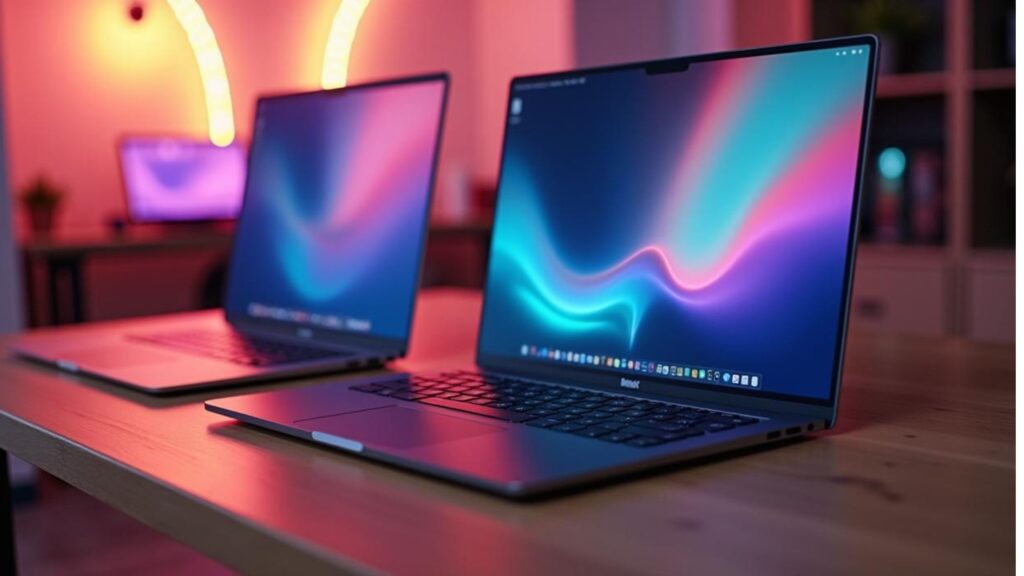Introduction
Are you curious about your laptop’s gaming performance? Understanding your laptop’s maximum FPS is crucial for a smooth gaming experience. This article will guide you through the process of How to Check My Laptop Max FPS, ensuring you get the best performance from your device.

Understanding FPS
Frames Per Second (FPS) is a critical metric for gamers and tech enthusiasts, indicating how many images are displayed per second on a screen. A higher FPS generally results in smoother and more fluid visuals, which is particularly important for gaming and other graphically intensive tasks. While a higher FPS is desirable, it’s important to note that not all displays can handle extremely high frame rates, so understanding your laptop’s capabilities is essential.
| Image | Product | Features | Price |
|
Our Pick
1

|
Acer Nitro V Gaming Laptop | Intel Core i9-13900H Processor | NVIDIA GeForce RTX 4060 Laptop GPU | 15.6″ FHD IPS 180Hz Display |
Model Name |
|
|
Our Pick
2

|
ASUS ROG Strix G16 Gaming Laptop, 16” 16:10 FHD 165Hz Display, NVIDIA® GeForce RTX™ 4060, Intel Core i7-13650HX |
Hard Disk Size |
|
|
Our Pick
3

|
Jumper Laptop, 16 Inch FHD IPS 1200p Screen, 5305U Processor, Office 365 1-Year Subscription, 4GB RAM 128GB Storage |
Screen Size |
Methods to Check Laptop FPS
Windows Game Bar
The Windows Game Bar is a built-in tool on Windows 10 and 11 that allows you to monitor your laptop’s FPS easily. Here’s how to use it:
- Activate the Game Bar: Press
Windows + Gon your keyboard to open the Game Bar. - Access Performance Metrics: Click on the “Performance” tab. This section provides real-time data about your system’s performance, including FPS.
- Select FPS Monitoring: Choose the “FPS” option to view the current frame rate. Note that this feature requires a game to be running to display accurate FPS data.
In-Game FPS Counters
Many games and platforms offer built-in FPS counters that can be enabled through their settings.
Steam:
- Launch Steam and navigate to the settings menu.
- In the settings, find the “In-Game” section and enable the FPS counter.
- Customize the position of the FPS counter on your screen for convenience.
Nvidia GeForce Experience:
- Open the Nvidia GeForce Experience application.
- Go to the “Settings” menu and select “HUD Layout.”
- Enable the FPS counter and choose its position on the screen for easy viewing.
Third-Party Software
For more detailed FPS monitoring and analysis, third-party software can be incredibly useful.
FRAPS:
- Download and install FRAPS from a reliable source.
- Launch FRAPS and configure hotkeys for overlay and benchmarking features.
- Start your game, and FRAPS will display FPS data in real-time.
MSI Afterburner:
- Install MSI Afterburner and ensure the “Rivatuner Statistics Server” is selected during installation.
- Open MSI Afterburner, click on the gear icon to access settings.
- In the “Monitoring” tab, enable “Framerate” under “Active Hardware Monitoring Graphs.”
- Check “Show in On-Screen Display” to view FPS during gameplay.
Factors Affecting Maximum FPS
Hardware Limitations
- Graphics Card: The capabilities of your GPU significantly impact FPS. Upgrading or optimizing your graphics card can enhance performance.
- Display Refresh Rate: A higher refresh rate (e.g., 144Hz) can support higher FPS, but it depends on the GPU’s ability to render frames at that rate.
Software Optimization
- Driver Updates: Keeping graphics drivers updated ensures optimal performance.
- In-Game Settings: Adjusting settings like resolution, texture quality, and shadows can improve FPS.
Troubleshooting Low FPS
Common Issues
- Bottlenecking: When one component (e.g., CPU or GPU) limits the performance of another, leading to reduced FPS.
- Background Processes: Closing unnecessary applications can free up resources for gaming.
Solutions
- Overclocking: Carefully increasing the clock speed of your CPU or GPU can boost FPS but requires proper cooling to prevent overheating.
- Hardware Upgrades: Consider upgrading components like RAM or storage to improve overall system performance.

Advanced FPS Monitoring Tools
Laptop FPS Benchmarking
- Tools: Discuss tools like FRAPS and MSI Afterburner for benchmarking and diagnostics. These tools allow users to test their system’s performance under various conditions and identify potential bottlenecks.
Laptop FPS Monitoring
- Real-Time Monitoring: Use in-game counters for real-time performance tracking. This feature helps gamers monitor their system’s performance during gameplay, allowing them to make adjustments as needed.
Also Read: Why Investing in Best Laptop Brands Guarantees Long-Term Value 2025
Conclusion
By understanding how to check and optimize FPS on your laptop, you can enhance your gaming experience significantly. Utilizing built-in tools and third-party software can help monitor performance effectively. Regular maintenance and optimization of both hardware and software components are key to achieving the best possible FPS. Encourage readers to apply these methods to enhance their gaming experience and explore further optimizations if needed.This article provides a comprehensive guide on determining your laptop’s maximum FPS, checking frame rates, measuring FPS, and using various tools for benchmarking and diagnostics. By following these steps, you can ensure your laptop delivers optimal gaming performance.
FAQs: How to Check Your Laptop’s Maximum FPS
Q: Why is it important to check my laptop’s maximum FPS?
Checking your laptop’s maximum FPS is crucial for ensuring a smooth gaming experience. Higher FPS provides smoother visuals and reduces lag, making games more enjoyable. Understanding your laptop’s FPS capabilities helps you optimize settings for better performance.
Q: How do I determine my laptop’s maximum FPS?
To determine your laptop’s maximum FPS, you can use tools like the Windows Game Bar, in-game FPS counters, or third-party software such as FRAPS and MSI Afterburner. These tools allow you to measure and monitor FPS during gameplay.
Q: What are the best tools for measuring laptop FPS?
The best tools for measuring laptop FPS include:
- Windows Game Bar: Built-in tool for Windows users to monitor FPS.
- FRAPS: Popular for detailed FPS monitoring.
- MSI Afterburner: Offers comprehensive FPS monitoring and overclocking features.
Q: How can I improve my laptop’s FPS performance?
Improving your laptop’s FPS involves several strategies:
- Update Drivers: Ensure your graphics drivers are up-to-date for optimal performance.
- Adjust In-Game Settings: Lower resolution and texture quality to increase FPS.
- Close Background Applications: Free up resources by closing unnecessary programs.
- Overclocking: Carefully increase CPU/GPU clock speeds for better performance.
Q: What is the optimal FPS for gaming?
The optimal FPS depends on your monitor’s refresh rate. A 60Hz monitor will display up to 60 FPS, while a 144Hz monitor can handle up to 144 FPS. For most games, 60 FPS is considered smooth, but higher FPS can enhance the experience.
Q: Should I limit my FPS to prevent overheating?
Limiting FPS can help manage heat levels, especially if your laptop tends to overheat at higher FPS settings. Balancing performance and temperature is key; consider limiting FPS to around 60-90 if overheating is a concern.
Q: How does my laptop’s hardware affect FPS?
Your laptop’s hardware significantly impacts FPS. A powerful GPU and recent-generation processor are essential for high FPS. Additionally, the display’s refresh rate limits the maximum FPS your laptop can achieve.
Q: Can I use third-party software to benchmark my laptop’s FPS?
Yes, third-party software like FRAPS and MSI Afterburner can be used for benchmarking and diagnostics. These tools help evaluate your laptop’s performance under various conditions.
Q: What is the difference between FPS and refresh rate?
FPS (Frames Per Second) measures how many frames your laptop can render per second, while refresh rate (measured in Hz) indicates how many times your display updates per second. The refresh rate limits the maximum FPS your display can show.
Q: How do I troubleshoot low FPS on my laptop?
To troubleshoot low FPS, identify potential bottlenecks such as outdated drivers or insufficient RAM. Solutions include updating drivers, adjusting in-game settings, closing background applications, and considering hardware upgrades.
Q: What are some common issues that affect FPS on laptops?
Common issues affecting FPS include:
- Bottlenecking: When one component limits another’s performance.
- Background Processes: Running unnecessary applications can reduce available resources.
- Outdated Drivers: Ensure all drivers are up-to-date for optimal performance.
Q: How can I optimize my laptop for better FPS performance?
Optimizing your laptop for better FPS involves:
- Updating Drivers: Keep graphics drivers current.
- Adjusting Settings: Lower resolution and texture quality in games.
- Closing Background Apps: Free up resources by closing unnecessary programs.
- Using Game Mode: Enable Game Mode in Windows settings to prioritize gaming applications.
Q: What is the role of cooling in maintaining FPS performance?
Proper cooling is essential for maintaining FPS performance. Overheating can lead to thermal throttling, reducing FPS. Ensure your laptop has adequate cooling solutions, such as using a cooling pad or stand.
Q: How does my display’s refresh rate impact FPS?
Your display’s refresh rate determines the maximum FPS it can display. A higher refresh rate (e.g., 144Hz) allows for higher FPS, but your GPU must be capable of rendering at that rate.
Q: Can I use in-game settings to monitor FPS?
Yes, many games offer in-game settings to monitor FPS. Enable these settings to track performance during gameplay and make necessary adjustments.
Q: What are some advanced tools for FPS monitoring and diagnostics?
Advanced tools for FPS monitoring include:
- FRAPS: Provides detailed FPS monitoring and benchmarking.
- MSI Afterburner: Offers comprehensive FPS monitoring and overclocking features.
- Nvidia GeForce Experience: Allows real-time FPS monitoring and performance tracking.


